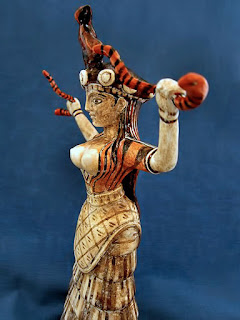看世界:手势与信仰
(Look at the world: gestures and beliefs)
黎显慧
手是远古人类交流的重要工具,先民常用手或手势来表达和传播宗教信仰。
霍皮人的岩画,美国科罗拉多州梅萨维德国家公园[1]
手印,洞穴绘画,阿根廷南部巴塔哥尼亚[2]
宁夏贺兰山岩画[3]
鹿和手印,西班牙阿尔塔米拉洞穴壁画,约公元前16500 - 12000年[4]
岩画中众多左手手印的出现,有其宗教原因。在金属武器产生之前,狩猎和战争中使用的是棍棒和石块,因此腋下通常是进攻和防守的重要部位。汉语中的“威胁”一词由此而来。由于左腋比右腋更易致命,为防护左腋不受伤害,左臂通常用来防护,久而久之,人们养成了用右手的习惯。
从后世宗教的尊右以及尊右手,可以推测岩画中左手印已经具有了宗教含义。先民以各种方式表示左手是属神的,以左手为尊成为世界原始宗教的重要特征。
左手拿着蛋的鸟神,1914年从复活节岛奥龙戈出土,大英博物馆[5]
鸟神的左手超大,右手被省略了。
埃及伊西斯女神[6]
伊西斯的左手和左臂明显要粗一些。
埃及法老阿肯那顿,公元前1345–1337年,柏林埃及博物馆[7]
法老阿肯那顿的左手很夸张,下面的几幅图也是。
乌普亚和内费塔里石碑的细节,埃及开罗萨卡拉提蒂金字塔北侧出土,埃及博物馆[8]
勺子,刻画了一个年轻卢特球员。埃及第18王朝。法国巴黎卢浮宫博物馆[9]
有翼的恶魔,公元前8世纪下半叶,安卡拉安纳托利亚文明博物馆[10]
赞美之屋博物馆 ,基多,厄瓜多尔[11]
风暴之神,雷电之神,公元前8世纪,赫梯宗教,小亚细亚地区[12]
米诺斯蛇女神,米诺文明,希腊[13]
斜倚在石棺盖上,陶瓷,伊特鲁里亚文明晚期(公元前3~2世纪),意大利[14]
除了用超大的左手来表示尊左,双手均为左手也是常见的一种方式。
国王准备弓箭,公元前645-635年,巴尼帕尔国王北宫,
亚述尼尼微,西亚。大英博物馆,英国伦敦[15]
美洲阿兹特克神话中的风神埃耶卡特尔[16]
特斯卡特利波卡,美洲阿兹特克神殿中最重要的神之一。里奥斯法典,公元16世纪[17]
钱蒂科是博吉亚法典阿兹特克神话中描述的女神,美洲[18]
一个哀悼的女人,来自图特摩斯三世墓,埃及18王朝,约公元前1479-1425年[19]
下面两幅图的双手发生了微妙的变化:
巴比伦主神马尔杜克和龙,巴比伦圆柱印章(描绘),美索不达米亚[20]
公元前十八世纪时期前后,马尔杜克(Marduk)成为巴比伦城的守护神。马尔杜克的双手均为左手,右边的手超大。既可以解释为尊左,也可以解释为名左实右。
浮雕,来自普塔霍特普II的马斯塔巴(墓),公元前2411-2378年,埃及第五王朝[21]
普塔霍特普II的左手与右手互换了位置,粗大的右手究竟是尊左还是尊右?早在第二王朝时期,古埃及就开始了由尊左转为尊右的宗教演变。普塔霍特普II的墓中浮雕并没有完工,但对称的格局已经出现,对称格局旨在模糊左右。可以推测硕大的右手是名左实右。
无论是东方还是西方,在人体的各部位中,手与手势是最早用来表达信仰的。以上所列举的只是最基本的手势。认识手与手势的起源、变化与发展,是认识宗教乃至世界文明的起源、变化与发展的重要途径。
[1] A Hopi petroglyph, in Mesa Verde National Park,Colorado. By National Park Service, From Wikimedia.
[2] Handprints,Cave Painting,Patagonia, southern Argentina.By MrV.Social Studies:2015,From bpsocialstudies.blogspot.com.
[3] 贺吉德著,丁玉芳整理:贺兰山岩画研究,宁夏人民出版社,2012年版,第13页。
[4] Deer and Hands.Altamira cave,paintings, Las Manos Cave, Argentina.Stone Age Art (ca. 16500 - 12000 BC)Spain.From realhistoryww.com.
[5] Bird-man with egg in hand. From Orongo, 1914. Bird-man in low relief with egg in hand. Length 36.5 cm. British Museum, Katherine Routledge: The Mystery of Easter Island, published 1919. From Wikimedia.
[6] Goddess Isis,© Darla Hueske - Goddess Isis - Friend of Artisans.
[7] Amenhotep IV (Akhenaten),1345–1337 BCE,Egypt. Egyptian Museum of Berlin.By mena7 ,From egyptsearch.com.
[8] Detail of The stele of Ipuia and Nefertari, Egypt, Cairo, Egyptian Museum,Saqqara, north side of Teti pyramid. By LiLei.
[9] A spoon with a handle in the form of a young lute player. 18th Dynasty, Egypt. Louvre Museum, Paris, France.From thefakebusters.com.
[10] Winged demon,ivory plaque,from Altintepe, second half of the eighth century BC.Ankara Anatolian Civilizations Museum.From Dick Osseman photos at pbase.com.
[11] Museo Casa del Alabado Quito ECUADOR.From lageoguia.org.
[12] The storm god, the god of thunder (8th century BC) (Hittite religion). From wikiwand.com.
[13] Minoan Snake Goddess.From veniceclayartists.com.
[14] Ceramic Figure reclining on sarcophagus lid.Late Etruscan 3rd and 2nd century BC.By Victor Bryant, From ceramicstudies.me.uk.
[15] Preparing the King's Bows and Arrows.645 - 635 BC.North Palace of King Ashurbanipal, Room c, Nineveh, Assyria.The British Museum, London, England.
[16] Quetzalcoatl, God of Wind and Wisdom,Quetzalcoatl,From wikipedia.
[17] Tezcatlipoca,one of the most important gods in the Aztec pantheon. Codex Rios, 16th century CE. From Ancient History Encyclopedia.
[18] Chantico (she who dwells in the house) was the goddess described in the Codex Borgia.Aztec mythology, Bodo Spranz (1975). From Wikipedia.
[19] A mourning woman , tomb of Minnakht (TT87). Thutmose III. 18th Dynasty, ca. 1479-1425 BC. Sheikh Abd el-Qurna, West Thebes.From egypt.egypt-museum.
[20] The chief deity of Babylon Marduk with a dragon , Babylonian cylinder seal. Illustration 9th century c. From magnoliabox.com.
[21] Reign,From The mastaba of Ptahhotep II(ca. 2411 - 2378 BCE),By Wim van den Dungen,From sofiatopia.org.




















